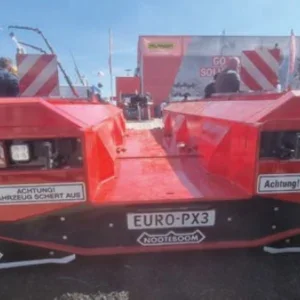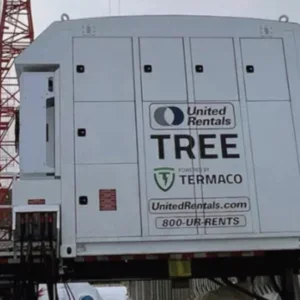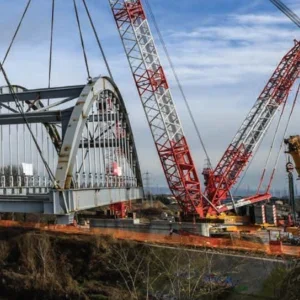For the first time, new crane operators in the UK must prove their competency in a regulated, industry-standard scheme in order to receive a full operator’s card. New crane operators must pass a national vocational qualification (NVQ) level 2 in Specialised Plant & Machinery Operations by 2006 in order to receive the new red Construction Plant Competence Scheme (CPCS) competent operator card.
The change is part of a shift in the industry toward documenting experience. The Construction Industry Training Board’s CTA (Certificate of Training Achievement) cards will disappear at the end of the year, though the CITB will continue to manage the new scheme. All existing CTA cardholders will be deemed competent and will begin receiving new red cards later in the year.
The CPCS scheme requires recordkeeping in other areas as well. Crane drivers and slinger/signallers will be required to log their experience for each of their endorsements. Those who do not log 300 hours of work by the time of their renewal three years in the case of new operators, five years for holders of existing CTA cards will have to sit a competency exam. If they fail the exam, they will no longer be able to drive the machinery, and their card will lose that particular endorsement.
The NVQ Level 2 qualification is based wholly on records of on the job experience. It requires that candidates produce at least two pieces of evidence that meet performance criteria in health and safety, efficiency, operations without a load, lifting and transferring and placing a load, according to Ian Fisher, director of training and development of Ainscough Training Services. He says that operators might expect to pass the qualification after two years of experience.
The scheme is not intended to guarantee the competence of a cardholder. Colin Wood, chief executive of the Construction Plant-Hire Association, says that the job of ensuring competency falls to the manager.
Says Fisher: ‘It’s a registration scheme to hold you accountable. It doesn’t discharge the responsibilities of the manager to make sure the crane driver is competent.’
Wood says it would be unlikely that CPCS cards would ever become policed and possibly rescinded by law, as driving licences are. ‘Imagine the administration, all the disputes, the aggravation,’ he says.
According to the Construction Industry Training Board, the agency that administers both schemes, the changes are designed ‘to measure an operator’s competence on an on-going basis, providing the industry and the individual with reliable proof of the cardholder’s ability to operate specified plant.’ Operators would use the logbook to record every job of theirs, according to John Varcoe, a member of the CPCS committee that developed the scheme, and manager safety training (technical) of the Construction Plant-Hire Association. He says that managers on site could use it to verify that they have relevant experience using an excavator to dig a ditch in a field could be very different in a tight urban location and could contact the company to confirm it.
Industry experts argue that cranes do not sit easily in this one-size-fits-all scheme, which will be implemented across the entire UK construction industry. ‘It’s trying to be all things to all men,’ says Fisher.
Unlike many other types of construction equipment, cranes are operated continuously by operators. That means the ongoing recordkeeping requirement 300 hours can be completed in six months. In theory, then, an experienced crane operator could be inactive for four and a half years and still have enough experience to make the cut.
‘There are areas where it might not be fully satisfactory,’ says Varcoe. ‘The alternative would be to produce different hours for different pieces of plant. You’ve got to keep it simple.’ He says that the benefit of one single scheme for the entire industry, for all types of plant outweighs the problems with the way the scheme fits particular types of plant. The scheme has been pushed on the industry by customers who have been looking for a way to keep up standards in a simple manner, according to Varcoe.
Some industry insiders are sceptical about the worth of the entire system. ‘Making crane drivers more qualified is just a joke to me,’ says Mark Ambridge, managing director of NMT Plant Hire. ‘We’ve got very expensive pieces of equipment. You don’t send an operator out with one unless you know he can drive it properly.’ According to Ambridge, the biggest risk-takers in the construction industry are the customers, who do not bother to create a safe working environment.
Fisher also raises concerns that the logbook entry scheme is open to abuse because it relies on trusting the crane operator and his or her supervisor not to falsify or fabricate imaginary job reports, even though it might be in their interests to do so. ‘It’s a “my mate down the pub” scenario,’ he says.
A CITB spokesperson responded that the log book concept and design has received a high satisfaction rating, according to research conducted by independent consultant OPERA on behalf of CITB.
Ainscough Crane Hire will be continuing its own training and accreditation system, which consists of a six-monthly on-site assessment tied in with rigging and tackle six-monthlies, and a more thorough test every five years. When asked if this scheme suggests that Ainscough doesn’t have much faith in the CPCS’s own recordkeeping initiatives, Fisher says, ‘No, the opposite it galvanises the spirit of the card scheme.’
Shaun Leinster, technical director at Marsh Plant says: ‘The single card system I think is a very good idea. I reserve judgement on the logbook until I see it.’ Leinster says he was worried that the system might become an ‘administrative nightmare.’ ‘I can assure you that to get an operator to sign a CTA form for renewal can result in quite a lengthy process.’ At the moment, CTA card holders only need re-sit a health and safety test every five years to receive a new card.
Leinster’s tentative plan (before attending a local meeting on the subject, in June) would be to hold logbooks centrally and update records himself, with help from depot managers. Otherwise ‘it’s two things to get lost rather than one’. (Marsh already holds CTA cards centrally). He would hold on to timesheets as proof of the hours, in case Marsh was audited by the CITB. For experienced crane drivers with a CTA card, the procedures will not change much. They will receive a new card sometime later this year, and from 1 January 2004 be required to start logging their hours. They must log 300 hours of operation within five years, or take a practical assessment in order to obtain their next red competent operator card. Those whose renewal dates come before five years will have to log a proportional number of hours, down to a minimum tk six months and 40 hours, on a pro-rata basis.
The biggest changes will affect those that do not have CTA cards. Starting 1 July, new UK operators must pass a training course called the Intermediate Construction Award (ICA) and sit a health and safety exam in order to receive a red card. This red card is not a competence card, but a certificate of training, as was the old CTA card. Over its three-year period of validity, these operators must log 300 hours of operation (about two months of nine-to-five, Monday to Friday work), pass the Specialised Plant & Machinery Operations NVQ Level 2 assessment, and sit the health and safety exam again. Then they receive a full experienced operator’s card, which is coloured blue.
Experienced workers without a CTA card will need to pass an assessment to get a red card, and then progress as do inexperienced operators.
Now read Diary of a trainee operator, links below






